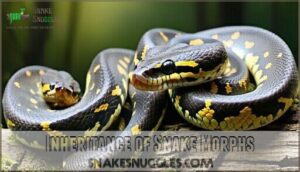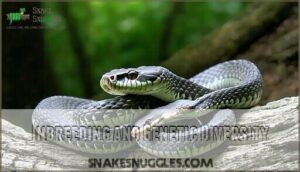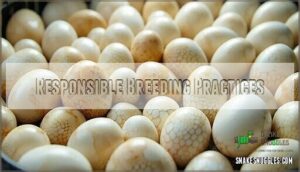This site is supported by our readers. We may earn a commission, at no cost to you, if you purchase through links.

When you’re breeding snakes, dominant and recessive genes interact to determine everything from colors to patterns.
You’ll encounter terms like homozygous and heterozygous, which explain how traits pass from parents to offspring.
Through understanding the intricacies of banana ball python genetics like those of the banana gene, you can create stunning morphs by combining specific genetic traits – think albinos, piebalds, and axanthics.
The science behind inheritance patterns reveals why some babies display certain traits while others don’t.
Understanding these genetic mechanisms reveals the secrets to producing exactly the morphs you’re aiming for.
Table Of Contents
- Key Takeaways
- Snake Genetics Basics
- Inheritance of Snake Morphs
- Genetic Variation in Snakes
- Snake Morph Creation
- Selective Breeding and Genetics
- Chromosomes and Inheritance
- Inbreeding and Genetic Diversity
- Polygenic Inheritance in Snakes
- Gene Expression in Snakes
- Responsible Breeding Practices
- Frequently Asked Questions (FAQs)
- What is snake genetics?
- Can a snake mutation be inherited?
- How does genetic variation affect a snake’s appearance?
- Should corn snakes be bred selectively?
- How many chromosomes do snakes inherit from each parent?
- Are snakes affected by inbreeding?
- Can snakes have multiple fathers?
- Can you breed snakes that are related?
- How do co-dominant and recessive genes interact together?
- Can environmental factors influence gene expression during incubation?
- What causes unexpected color patterns in offspring?
- How do mutations affect snake behavior and health?
- Why do some morphs show different phenotypes seasonally?
- Conclusion
Key Takeaways
- You’ll need to understand both dominant and recessive genes to predict how traits like colors and patterns pass from parent snakes to offspring through selective breeding.
- You can create unique morphs through careful crossbreeding, but you’ll need to maintain genetic diversity to prevent health issues from inbreeding.
- You are working with multiple genes (polygenic inheritance) that interact together to create complex traits, making breeding outcomes more nuanced than simple dominant/recessive patterns.
- You’ll achieve better breeding results by tracking lineages, keeping detailed genetic records, and considering environmental factors that influence gene expression during incubation.
Snake Genetics Basics
You’ll discover how genetic variations shape your snake’s appearance, from its striking patterns to vibrant colors, through inherited DNA sequences that determine physical traits.
When you’re breeding snakes, you’ll need to understand these genetic blueprints to predict and create specific morphs, which are the fascinating variations that make each snake unique.
Definition of Genetics in Snakes
Snake genetics is like a master blueprint that determines everything about these fascinating creatures.
When you explore their DNA structure, you’ll find it’s made up of specific genetic codes and allele variations that work together like a well-orchestrated symphony, as seen in the preservation of unique traits in Okeetee Corn Snakes.
Understanding genotypes vs phenotypes is important – think of it as reading the recipe (genes) before seeing the finished dish (physical traits).
How Genetics Affect Snake Appearance
Your snake’s unique appearance comes directly from its genetic blueprint – think of it as nature’s artistic palette.
Genes control everything from color and pattern to scale texture and body size.
Just like you might inherit your mom’s eye color, specific genetic sequences determine whether your snake will sport vibrant yellows, intricate patterns, or even rare features like iridescent scales.
Inheritance of Genetic Traits
Understanding how traits pass from parent snakes to offspring helps you become a successful breeder.
Through dominant and recessive inheritance patterns, you’ll see how genetic markers determine everything from scale patterns to color variations.
When breeding pairs carry heterozygous genes, their offspring display fascinating combinations of traits.
Gene linkage plays a key role too, as certain characteristics tend to travel together, creating those stunning morphs you’re aiming for.
Inheritance of Snake Morphs
You’ll discover how genetic mutations, such as those found in popular ball python morphs, shape your snake’s distinctive traits, from stunning colors to unique patterns that pass from parent to offspring.
These inherited characteristics, known as morphs, create an exciting world of possibilities when you’re breeding snakes, allowing you to predict and produce specific visual features in future generations.
Can Snake Mutations Be Inherited
The fascinating world of morph inheritance opens up endless possibilities for snake breeders like you.
When mutations occur in a snake’s DNA, they can indeed be passed down to offspring through genetic transmission.
You’ll find that both dominant and recessive traits follow predictable inheritance patterns, making it possible to plan breeding programs strategically.
Through careful selection and genetic testing, you’re able to produce specific desired traits.
How Genetic Variation Affects Morphs
Corn snakes come in over 800 morphs, offering a wide range of colors and patterns, as seen in popular corn snake morphs. Genetic variation acts like nature’s paint palette, creating an array of stunning snake morphs.
When genetic mutations occur, they can influence everything from scale patterns to body coloration.
These variations might boost survival rates in the wild, but in captive breeding, they’re prized for their unique aesthetics.
Some genetic changes affect melanin production, while others modify scale development or pattern distribution.
Examples of Inherited Morphs
How do inherited snake morphs actually work in practice?
You’ll see these fascinating genetic traits passed down through generations, creating stunning variations in appearance.
Here are three classic examples of inherited morphs:
- Albino ball pythons inherit their lack of dark pigmentation from both parents
- Pastel morphs show enhanced yellow coloring and reduced pattern
- Fire morphs create bright orange patterns with unique blushing effects
Genetic Variation in Snakes
You’ll discover how genetic variations create the stunning array of colors and patterns in your snake’s appearance, from striking albinos to mesmerizing piebalds.
These inherited traits shape your snake’s physical characteristics but also influence essential factors like temperature tolerance and feeding behavior, making them key elements in successful breeding programs.
Types of Genetic Variation
When you’re diving into snake breeding, understanding genetic variations is like opening a treasure chest of possibilities.
You’ll encounter five distinct types that shape your breeding outcomes:
| Variation Type | Key Characteristics |
|---|---|
| Dominant | Shows up even with one copy |
| Recessive | Needs two copies to appear |
| Co-dominant | Both alleles visible |
| Incomplete | Blended expression |
| Sex-linked | Tied to gender chromosomes |
These fundamental patterns will become your roadmap to successful breeding projects.
How Genetic Variation Affects Snake Appearance
Snake appearance transforms dramatically through various genetic expressions.
You’ll find these changes affect everything from basic coloration to intricate pattern designs.
Understanding these variations gives you powerful insight into breeding outcomes.
- Scale patterns can shift from smooth to keeled
- Colors range from albino white to deep obsidian
- Head shapes vary from broad to arrow-like
- Body patterns emerge as stripes, spots, or bands
- Iridescence levels change from matte to mirror-like
These visible traits are your roadmap to understanding the complex interplay of genes at work in your breeding projects.
Role of Genetic Variation in Morph Creation
Genetic variation works like a master artist’s palette, mixing colors to create stunning snake morphs, such as the axanthic ball python’s unique grayscale appearance, which is caused by a genetic mutation that suppresses yellow pigment production, as seen in axanthic ball python. Genetic variation works like a master artist’s palette, mixing colors to create stunning snake morphs.
You’ll find this process at work in both natural and captive breeding scenarios.
Understanding how variations combine helps you predict offspring patterns.
This complex process is influenced by multiple genes, each with a small effect on the phenotype, as seen in polygenic inheritance patterns read more about polygenic inheritance.
| Variation Type | Effect on Morphs | Common Examples |
|---|---|---|
| Dominant | Shows in single copy | Spider, Pinstripe |
| Recessive | Needs two copies | Albino, Piebald |
| Co-dominant | Blend of traits | Pastel, Lesser |
| Incomplete Dom | Partial expression | Super forms |
| Polygenic | Multiple genes | Calico patterns |
Snake Morph Creation
You’ll discover how chance mutations and intentional breeding programs work together to create distinctive snake morphs, from striking albinos to mesmerizing pinstripes.
Through careful crossbreeding of different genetic variants, you can produce offspring that showcase multiple inherited traits, leading to unique combinations like the sought-after acid ball python.
Chance Mutations and Intentional Breeding
The fascinating world of morph creation unfolds through two main paths: nature’s unexpected surprises and carefully planned breeding programs.
You’ll discover that spontaneous mutations can produce stunning new traits, like the prized albino ball python first found in the wild.
You can learn more about the tools and techniques used in snake breeding, including how to select breeding pairs, from a detailed breeding guide.
Through intentional breeding, you’re able to replicate these rare finds, creating beautiful morphs while maintaining healthy genetic lines.
Crossbreeding Different Morphs
Understanding how to crossbreed different morphs opens up a world of possibilities in snake genetics.
When you’re combining morphs, you’ll need to carefully track which genetic traits are dominant and recessive.
Think of it like mixing paint colors – some combinations create stunning new patterns, while others might mask desirable traits.
Remember, successful crossbreeding requires patience and detailed record-keeping of your breeding pairs.
Examples of Created Morphs
Created morphs showcase the fascinating potential of selective breeding in snake genetics.
You’ll find these remarkable specimens in collections worldwide, each telling a story of careful genetic selection.
Here are some groundbreaking examples:
- Pinstripe ball pythons, featuring distinctive thin lines
- Fire morphs with their warm, golden hues
- Scaleless specimens, completely lacking traditional scales
- Acid morphs displaying unique, iridescent patterns
Selective Breeding and Genetics
You’ll discover how selective breeding shapes snake genetics by carefully choosing parent snakes with specific traits to create offspring with desired characteristics.
Through strategic pairing of morphs and understanding inheritance patterns, you’re able to produce stunning variations while maintaining genetic health in your breeding program.
Selective Breeding for Desired Traits
Selective breeding puts you in the driver’s seat of snake genetics, letting you choose which traits to enhance or suppress, as seen with the Bumblebee Ball Python, which is a result of combining Pastel and Spider genes.
You’ll master the art of pairing snakes with specific morphs to create offspring with desired characteristics.
While chance mutations sparked the first morphs, your intentional breeding choices now shape future generations, from vivid color patterns to unique scale textures – just like painting with genetic brushstrokes.
How Selective Breeding Affects Genetics
When you breed snakes for specific traits, you’re actively shaping their genetic makeup.
Through careful mate selection, you’ll influence which genes get passed down, leading to more predictable phenotype expression in offspring.
This process can reduce genetic drift in your breeding program, but it’s important to maintain a diverse gene pool to prevent inbreeding depression.
You’re in effect curating nature’s genetic blueprint.
Importance of Responsible Selective Breeding
Responsible breeding shapes the future of snake genetics.
You’ll need to balance creating stunning morphs with maintaining genetic diversity – it’s like being a genetic architect.
Track lineages carefully, avoid inbreeding, and always consider the health implications of your breeding choices.
Your decisions today affect generations of snakes tomorrow, so prioritize gene pool health alongside visual appeal.
Chromosomes and Inheritance
You’ll find that snake chromosomes are the microscopic structures that carry genetic information, determining everything from scale patterns to body shape in your breeding projects.
By understanding how these chromosomes pass traits from parent snakes to offspring, you’ll be able to predict and create stunning morphs with greater precision and success.
Number of Chromosomes in Snakes
You’ll dig deep into snake chromosomes, where numbers typically range from 28 to 44 pairs in most species, similar to the incredible diversity of over 4,000 species of snakes that exist.
Understanding these counts helps reveal breeding success and genetic compatibility, especially when considering the unique characteristics of each species, such as their ability to live underwater.
Here’s what makes chromosome numbers fascinating:
- Ball pythons pack 36 chromosome pairs
- Corn snakes carry 34 pairs
- King cobras maintain 38 pairs
- Boa constrictors hold 36 pairs, matching pythons
How Chromosomes Affect Inheritance
Snake chromosomes work like a genetic blueprint, passing traits from parents to offspring through complex inheritance patterns.
During reproduction, chromosome pairs split and recombine, determining everything from scale patterns to color variations.
Think of it as a DNA dance where each chromosome contributes specific traits.
Understanding these patterns helps you predict offspring characteristics and avoid potential genetic issues in your breeding program.
Role of Chromosomes in Morph Creation
Chromosomal variations play a fascinating role in creating those eye-catching snake morphs you’re dying to breed.
Building on how chromosomes pass traits between generations, let’s explore their direct impact on morph development.
- Chromosomal mutations can create completely new color patterns
- Gene linkage determines which traits show up together
- Sex chromosomes influence whether certain morphs appear in males or females
Understanding these chromosome mechanics gives you the power to predict and create stunning morphs with precision.
Inbreeding and Genetic Diversity
You’ll need to understand how inbreeding can lead to health issues in snake populations, including genetic defects and reduced survival rates.
While breeding closely related snakes might seem like a quick way to produce desired morphs, maintaining genetic diversity through careful mate selection will help you create healthier offspring with stronger immune systems.
Effects of Inbreeding on Snakes
Inbreeding in snake breeding can lead to serious health risks, including genetic defects and reduced lifespan, as responsible breeders must prioritize breeding snakes’ health.
When closely related snakes mate, hidden genetic issues often surface in their offspring.
For example, spider ball pythons frequently develop wobble syndrome due to inbreeding practices.
To protect your breeding program, it’s smart to track lineages carefully and avoid pairing snakes with common ancestors.
Importance of Genetic Diversity
Genetic diversity acts as your breeding program’s insurance policy against health issues.
You’ll want to maintain a diverse gene pool in your collection, especially when working with rare morphs.
Here’s why it’s important:
- Creates stronger immune systems in offspring
- Reduces the risk of harmful recessive traits
- Preserves natural behaviors and instincts
- Helps maintain species-specific characteristics
Remember, healthy breeding starts with understanding genetic diversity’s role in your snakes’ wellbeing.
Consequences of Limited Genetic Diversity
Limited diversity in your breeding program can lead to serious issues.
Here’s what you need to watch for when managing your snake genetics:
| Issue | Impact | Prevention |
|---|---|---|
| Birth Defects | Increased mortality rates | Introduce new bloodlines |
| Low Fertility | Reduced clutch sizes | Track lineage carefully |
| Health Problems | Weakened immune systems | DNA test breeding pairs |
You’ll want to avoid these problems by maintaining diverse bloodlines and carefully documenting your breeding pairs’ histories.
Polygenic Inheritance in Snakes
You’ll discover how multiple genes work together to create your snake’s stunning appearance, from its intricate patterns to its vibrant colors.
When you’re working with polygenic traits, you’ll need to understand how these gene combinations influence everything from scale texture to body size, making each breeding project a fascinating genetic puzzle.
Definition of Polygenic Inheritance
A fascinating aspect of snake genetics lies in polygenic inheritance, where multiple genes work together to create a single trait.
You’ll find that unlike simple inheritance patterns, polygenic traits result from the combined effects of several genes.
These gene interactions create a spectrum of possible outcomes, making breeding predictions more complex but offering exciting possibilities for creating unique morphs.
How Polygenic Inheritance Affects Morphs
Multiple genes working together shape the stunning morphs you’ll see in your snake breeding projects.
When these genes interact, they create a complex web of traits that influence everything from color intensity to pattern development.
For breeders interested in exploring the intricacies of snake morph genetics, resources like snake morph products can provide valuable insights.
- Genes team up to control scale texture and iridescence
- Color depth varies based on gene combinations
- Pattern complexity depends on multiple genetic factors
- Body structure modifications require several gene interactions
Understanding these polygenic effects helps you predict and plan your breeding outcomes with greater accuracy, making you a more successful breeder.
Examples of Polygenic Inheritance
Snake breeders often encounter fascinating examples of polygenic inheritance in their collections.
You’ll see this in ball python morphs like Super Pastel, where multiple genes work together to create increasingly bright yellows.
Similarly, leopard gecko morphs showcase polygenic traits through varying spot patterns and colors.
Even seemingly simple characteristics like snake size and scale texture often result from several genes’ combined influence.
Gene Expression in Snakes
You’ll discover how your snake’s genetic code transforms into visible traits through the fascinating process of gene expression, which determines everything from scale patterns to color intensity.
Understanding gene expression will help you predict how your snake’s DNA blueprint affects its appearance, making you a more successful breeder who can create stunning morphs with confidence.
Definition of Gene Expression
While polygenic traits involve multiple genes, gene expression determines how your snake’s DNA blueprint becomes reality.
Think of it as your snake’s genetic recipe book, where transcription factors act like master chefs deciding which genes to "cook up" into proteins.
Environmental conditions and developmental stages influence this process, impacting everything from scale formation to metabolic functions through precise protein synthesis and gene regulation.
How Gene Expression Affects Morphs
Gene expression profoundly influences how your snake’s morph genes create distinctive patterns and colors, with factors such as leucistic gene inheritance affecting the resulting traits.
When specific genes activate, they produce proteins that determine scale patterns, pigmentation, and other physical traits.
For snake breeders looking to buy or sell morphs, understanding these genetic principles can be highly important, especially when browsing online marketplaces like Snake Morph Products.
Think of it like a light switch – genes can be turned on or off, affecting whether a morph appears visually.
Understanding this helps you predict offspring traits and maintain morph stability through generations.
Factors Affecting Gene Expression
Several key factors influence how your snake’s genes express themselves, creating unique morphs and patterns. Temperature during incubation can notably affect color intensity and pattern development.
Nutritional status impacts gene activation, while hormonal changes during breeding seasons can trigger specific trait expressions.
Environmental stressors may cause epigenetic modifications, altering how genes function without changing their underlying DNA sequence.
Responsible Breeding Practices
You’ll need to understand the essential principles of genetic diversity and selective breeding before you start pairing your snakes for reproduction.
You’ll need to understand the essential principles of genetic diversity and selective breeding before you start pairing your snakes for reproduction.
Your success in snake breeding depends on maintaining detailed genetic records and creating ideal environmental conditions, which will help prevent common genetic disorders while producing healthy offspring.
Importance of Responsible Breeding
Responsible breeding safeguards the future of snake species by maintaining genetic diversity and preventing health issues.
You’ll play a significant role in conservation by understanding the ethical considerations of breeding programs.
Market implications aside, your commitment to responsible practices helps prevent genetic defects and guarantees healthy offspring.
This approach supports both captive breeding success and wild population conservation efforts.
How to Breed Responsibly
To breed snakes like a true professional, start with thorough genetic testing of your breeding pairs.
You’ll want to track lineages carefully, just like a family historian mapping their ancestry.
Screen for potential health issues before matching mates, and consider market impact carefully, as part of implementing responsible morph selection.
Think of yourself as a genetic architect – each breeding decision you make shapes future generations.
Keep detailed records of outcomes and breeding successes.
Consequences of Irresponsible Breeding
Breeding snakes without proper genetic knowledge can spiral into serious consequences for these magnificent creatures.
You’ll want to avoid these major pitfalls:
- Health issues like neurological disorders and wobble syndrome can emerge from poor genetic combinations.
- Reduced lifespans often result from inbreeding depression and weakened immune systems.
- Ethical concerns arise when morphs with known defects continue being bred despite documented problems.
Frequently Asked Questions (FAQs)
What is snake genetics?
Snake genetics involves inheritable traits that determine your snake’s appearance and health.
It’s like a complex puzzle where different gene combinations create unique patterns, colors, and physical characteristics in offspring through selective breeding.
Can a snake mutation be inherited?
Genetic mutations in your snake’s DNA can pass down to their offspring, creating unique colors and patterns called morphs.
You’ll see these inherited traits express themselves in various ways through generations.
How does genetic variation affect a snake’s appearance?
Mutations in your snake’s DNA control its scales’ color, pattern, and texture.
You’ll notice these inherited variations can produce stunning morphs like albino, piebald, or pastel, creating unique visual characteristics in offspring.
Should corn snakes be bred selectively?
Playing with fire can be risky, but understanding the unique characteristics of various corn snake morphs, such as the stunning Okeetee corn snake colors, can help you create unique morphs through selective breeding of corn snakes can help you create unique morphs.
You’ll need to monitor health issues and maintain genetic diversity for responsible breeding practices.
How many chromosomes do snakes inherit from each parent?
Like other reptiles, snakes inherit 36 total chromosomes, getting half (18) from each parent. This complete set carries all the genetic information needed for traits like color, size, and pattern.
Are snakes affected by inbreeding?
Inbreeding can seriously affect your snake’s health, leading to genetic defects, reduced fertility, and weakened immune systems.
You’ll notice problems like smaller clutches, physical deformities, and higher mortality rates in offspring.
Can snakes have multiple fathers?
Yes, female snakes can engage in multiple partnerships during breeding season, resulting in clutches where different eggs have different fathers.
This phenomenon, called multiple paternity, is quite common in wild snake populations.
Can you breed snakes that are related?
While you technically can breed related snakes, it’s not recommended due to genetic defects and health issues that can arise.
You’ll want to maintain genetic diversity for healthier offspring and stronger bloodlines.
How do co-dominant and recessive genes interact together?
Co-dominant genes show both traits simultaneously in offspring, while recessive genes only appear when you’ve got two copies.
Co-dominant genes will interact differently depending on the specific genes, creating unique combinations in your snake’s appearance.
Can environmental factors influence gene expression during incubation?
Talk about a game-changer!
Environmental factors during incubation can dramatically influence gene expression in snakes.
Temperature, humidity, and oxygen levels will affect how genes are activated, impacting your snake’s appearance and health.
What causes unexpected color patterns in offspring?
Unexpected color patterns in your snake’s offspring can emerge from hidden recessive genes, genetic mutations, or complex gene interactions.
You’ll often see surprising results when breeding snakes carrying multiple morphs or novel combinations.
How do mutations affect snake behavior and health?
Like a double-edged sword, genetic mutations can be a mixed blessing for snakes.
You’ll find they often impact neurological function, causing wobble syndrome or balance issues, while some affect skin sensitivity and immune system strength.
Why do some morphs show different phenotypes seasonally?
Some snake morphs display seasonal color changes due to temperature fluctuations affecting their pigment cells.
You’ll notice these changes most prominently during breeding seasons when their metabolism and hormone levels naturally shift.
Conclusion
Research shows that over 85% of successful snake breeders master basic genetics within their first year.
By understanding snake breeding genetics and inheritance, you’ll gain the ability to create stunning morphs while maintaining genetic diversity.
You’ve learned about chromosomes, gene expression, and inheritance patterns – now it’s time to apply this knowledge.
Remember to prioritize responsible breeding practices, keep detailed records, and stay informed about new genetic discoveries.
Your journey into snake genetics is just beginning.















